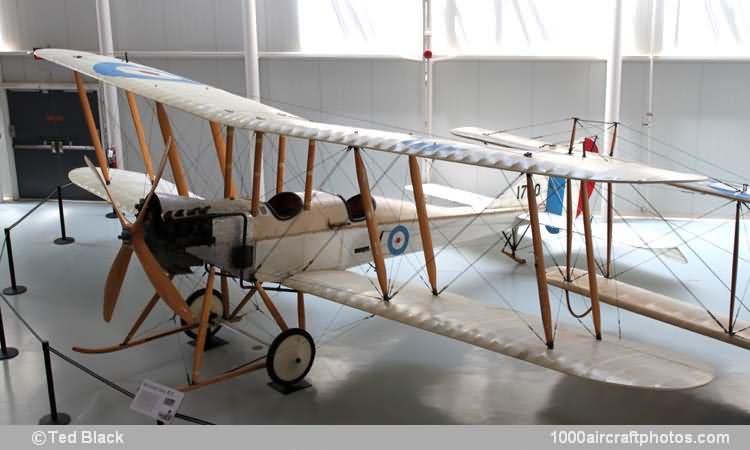05/31/2011. Remarks by Johan Visschedijk: "Second of the Farnborough designs to bear a "Bleriot Experimental" designation as a general-purpose tractor biplane, the B.E.2 appeared in 1912 and provided the basis for a family of variants produced in large quantity for use by the RFC, principally as an unarmed two-seat
scout. With modifications to enhance the inherent stability of the basic design, the B.E.2c was developed in 1914 and many of the 1,216 of this variant built were to serve with various ad hoc armament installations.
The B.E.2c was a two-bay biplane with unstaggered equi-span wings, a conventional tail unit with separate fin, rudder, tail plane and elevators, and an landing gear incorporating skids to help prevent nose-overs. The 70 hp Renault eight-cylinder V-engine powered early production aircraft, but the 90 hp RAF 1a eight-cylinder V-engine soon became standard. Construction of the B.E.2c was of wood throughout, with fabric covering. A variety of mounts was evolved for a single 0.303 in (7.7 mm) Lewis machine gun in the observer's (front) cockpit, primarily for self-defense.
More specifically to serve as a fighter with Home Defence squadrons of the RFC and the RNAS, numerous B.E.2c's were modified as single-seaters, armament comprising a single Lewis gun mounted to fire upwards behind the wing center section or, in some cases, on the side of the fuselage alongside the cockpit, angled outwards to clear the propeller disc. Flying by night, despite a lack of nocturnal flight aids, B.E.2c's shot down five raiding Zeppelins over the UK during 1916. B.E.2c's were also used for a number of armament experiments.
The pictured aircraft was built by Armstrong Whitworth, and is one of the aircraft flown by the later British ace and Major Lanoe George Hawker (December 30, 1890 – November 23, 1916). After 25 flying hours at the Central Flying School, the then Lieutenant Hawker was assigned to No. 6 Squadron on October 5, 1914, and arrived at Bruges, Belgium, two days later. On April 18, 1915, flying the above B.E.2c, Hawker attacked a German zeppelin shed at Gontrode near Ghent. For this action Hawker earned the Distinguished Service Order (DSO), and subsequently was promoted to Captain.
Hawker was the third pilot to earn the Victoria Cross (VC) after attacking three aircraft in succession on one flight on July 25, 1915, destroying two and damaging one. On September 7, 1915, flying the Bristol Scout C, serial 1611, Hawker scored his seventh and last victory, when he downed a German scout aircraft over Bixschoote. On September 20, he was posted back to England to take up command of the newly formed No. 24 squadron. On October 5, Hawker was decorated by King George V with the DSO and VS he had earned earlier in the year.
Hawker was promoted to Major on February 3, 1916, four days later he and his squadron moved to Saint-Omer, France. Although forbidden to fly, Hawker continued to do so. On November, flying Airco D.H.2 serial 5964, Hawker was killed in a dog fight (reportedly one of the longest of WW I) with the German ace Freiherr Manfred von Richthofen, flying an Albatros D.II, serial 491/16."
